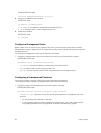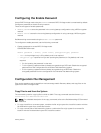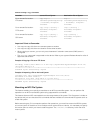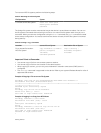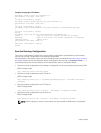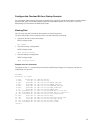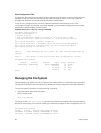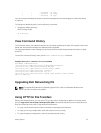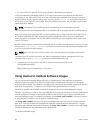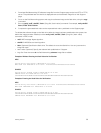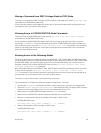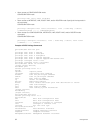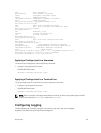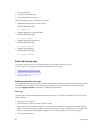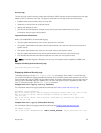
• To copy a file on the external FLASH, enter usbflash:// followed by the filename.
In the Dell Networking OS release 9.8(0.0), HTTP services are enhanced to support the VRF-aware
functionality. If you want the HTTP server to use a VRF table that is attached to an interface, configure
that HTTP server to use a specific routing table. You can use the ip http vrf command to inform the
HTTP server to use a specific routing table. After you configure this setting, the VRF table is used to look
up the destination address.
NOTE: To enable HTTP to be VRF-aware, as a prerequisite you must first define the VRF.
You can specify either the management VRF or a nondefault VRF to configure the VRF awareness setting.
When you specify the management VRF, the copy operation that is used to transfer files to and from an
HTTP server utilizes the VRF table corresponding to the Management VRF to look up the destination.
When you specify a nondefault VRF, the VRF table corresponding to that nondefault VRF is used to look
up the HTTP server.
However, these changes are backward-compatible and do not affect existing behavior; meaning, you can
still use the ip http source- interface command to communicate with a particular interface even
if no VRF is configured on that interface
NOTE: If the HTTP service is not VRF-aware, then it uses the global routing table to perform the
look-up.
To enable an HTTP client to look up the VRF table corresponding to either management VRF or any
nondefault VRF, use the ip http vrf command in CONFIGURATION mode.
• Configure an HTTP client with a VRF that is used to connect to the HTTP server.
CONFIGURATION MODE
Dell(conf)#ip http vrf {management | <vrf-name>}
Using Hashes to Validate Software Images
You can use the MD5 message-digest algorithm or SHA256 Secure Hash Algorithm to validate the
software image on the flash drive, after the image has been transferred to the system, but before the
image has been installed. The validation calculates a hash value of the downloaded image file on system’s
flash drive, and, optionally, compares it to a Dell Networking published hash for that file.
The MD5 or SHA256 hash provides a method of validating that you have downloaded the original
software. Calculating the hash on the local image file, and comparing the result to the hash published for
that file on iSupport, provides a high level of confidence that the local copy is exactly the same as the
published software image. This validation procedure, and the verify {md5 | sha256} command to support
it, can prevent the installation of corrupted or modified images.
The verify {md5 | sha256} command calculates and displays the hash of any file on the specified local
flash drive. You can compare the displayed hash against the appropriate hash published on i-Support.
Optionally, the published hash can be included in the verify {md5 | sha256} command, which will display
whether it matches the calculated hash of the indicated file.
To validate a software image:
58
Getting Started



